The pandemic hasn’t just affected humans, it’s affected your dogs and pups too. It has affected our daily lives-some of us work from home and that means spending a lot more time with our pets at home.
During the pandemic, the number of new dogs and puppies coming into households exploded, and “pandemic pups” have become one of the many defining features of the pandemic.
Initially, pandemic puppies helped humans feel less lonely in times of isolation. Flash forward to a year later, and pandemic pups have grown and pandemic restrictions have softened. As a result, their human halves may be spending more time away from the home-which means less time with their pup.
The reality is, living with a dog now may be harder than it was when the pandemic first started. Much like how humans have transitioned back to life before the pandemic, dogs also need to adjust. For puppies that are used to routines created during the pandemic, there could be an issue adjusting to having their humans around less of the time, which could result in issues like separation anxiety, stress, and a lack of socialization.
Dog Behavior and the Pandemic
How has the pandemic changed the behavior of pets? If you notice behavioral changes in dogs, it could be in relation to the loss of old routines. Here are some behavioral issues to look for in dogs and the reason they may be occurring with expert opinions from Dr. Lazarowski, Ph.D.:

Dr. Lazarowski
Dr. Lazarowski is a Research Assistant Professor at Auburn University’s College of Veterinary Medicine and Chief Scientist with the Canine Performance Sciences program. Her research focuses on working dog behavior, including development, cognition, and welfare.
Socialization
In the early days of the pandemic, when people didn’t leave the house, there were not many chances to socialize your puppy.
“Experiences during a puppy’s first few months of life have a big impact on their behavior as an adult because their brains are rapidly changing, essentially being programmed as the puppy learns how to interact with the world. Developing puppies need adequate socialization during this time, which should consist of introducing them to a variety of people, situations, and objects. Once this developmental stage passes, puppies that lacked these experiences may be fearful of them later in life. With lockdowns and social distancing, puppies that underwent this important phase of development during the pandemic may have had limited opportunities for meeting other people and dogs or exploring new environments.”
Separation anxiety
If you find yourself recently going back to the office or place of work, leaving your furry friend behind, your pup may not be used to this. This new change in routine can cause separation anxiety in dogs.
“Dogs that became accustomed to their people being home for extended periods will likely require some adjusting to being home alone again, and trainers and veterinarians are reporting increases in dogs with separation issues. This issue is probably worse in puppies acquired during the pandemic who have never really experienced separation.”
Other behavioral issues
While pandemic brought on issues like socialization and separation anxiety, many pet parents saw this time as a good opportunity to spend more time with their dogs while working from home:
“Aside from the negative effects of the pandemic, many pet owners took advantage of the extra time at home to train with their dogs. Working from home is an opportune time for things like crate training, potty training, or addressing separation anxiety where owners can start with brief sessions and gradually build up the amount of time the dog is crated or left alone, which can be difficult to structure when working full time outside of the home. Researchers studying dog behavior and cognition had to pivot from bringing dogs into their labs on university campuses to designing at-home methods that allowed owners to participate remotely, which many people saw as a great opportunity for new ways to bond with their dogs or provide enrichment.”
Stress in Dogs
Dogs can be stressed just like humans. A contributing factor to stress in dogs can be a change in lifestyle. It’s important to approach these new changes with your dog gradually to reduce stress. Here are some tips from Dr. Lazarowski:
“Stress in dogs can manifest in different ways. Some dogs deal with stress by becoming hyper-reactive while others become inhibited and withdrawn. Stress can be caused be negative emotions like fear and anxiety, or can result from becoming overly excited and not knowing how to manage those emotions. For owners venturing out of their homes with their dogs again, it’s important to gradually re-introduce dogs to situations they have not experienced in a while (or ever, for under-socialized puppies) and to pay attention to subtle behaviors. If the dog shows any signs of stress, it’s important to back off and give the dog the time and space to adapt. Dogs exhibiting moderate to pronounced stress may benefit from behavior modification training.”
Signs of Stress
Knowing the signs of stress can be helpful. Here are some signs to look for in stress:
Stiff body
Growling
Barking, howling, and whining
Panting or drooling (when it’s not hot)
Excessive licking and scratching
Trembling
Lip-licking
Pacing
Yawning
Urination
Defecation
Holding one leg up
Pupil dilation
Whale eye (seeing the whites of your dog’s eyes)
Wet dog shake (when not wet)
Inability to eat treats (when you’re not with your dog)
What Parents Are Doing to Help Their Pets
Pandemic puppies experience behavioral and socialization challenges. How did pet parents respond to their pet’s needs during the pandemic? In a survey conducted on pet behavior, here are some of the findings on what pet parents did to combat the issues caused by the pandemic.
Pet Socialization
Developing puppies need adequate socialization, which has certainly been a challenge during the pandemic. After 2020, pet parents went the extra mile to socialize their pets during 2021. One common trend was adding another pet to the household.
Getting another pet
In 2021, 59% of pet parents got another pet, or considered getting another pet:
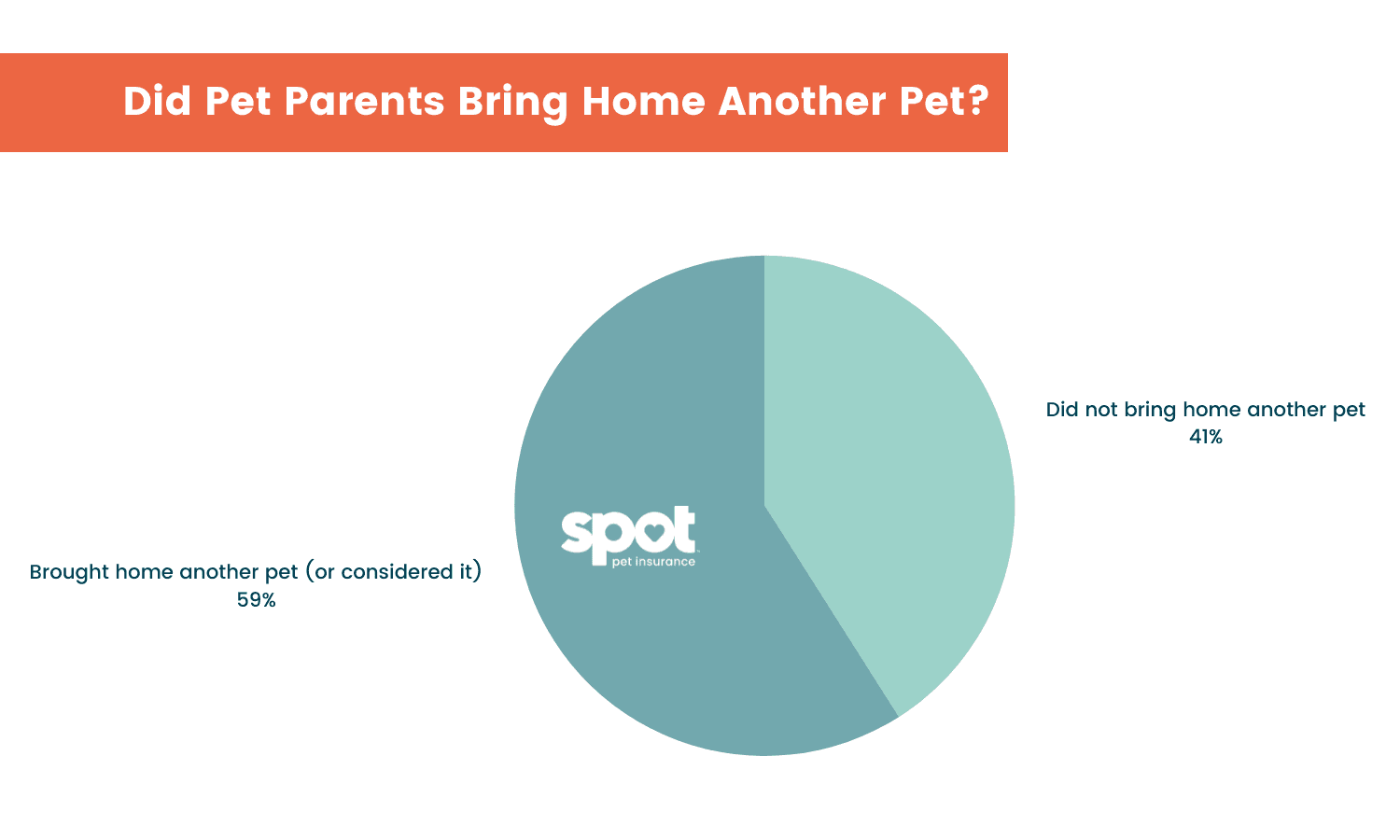
Reasons why parents got another pet
What were the reasons for pet parents getting another pet? Here were the most common reasons why pet parents got another pet.
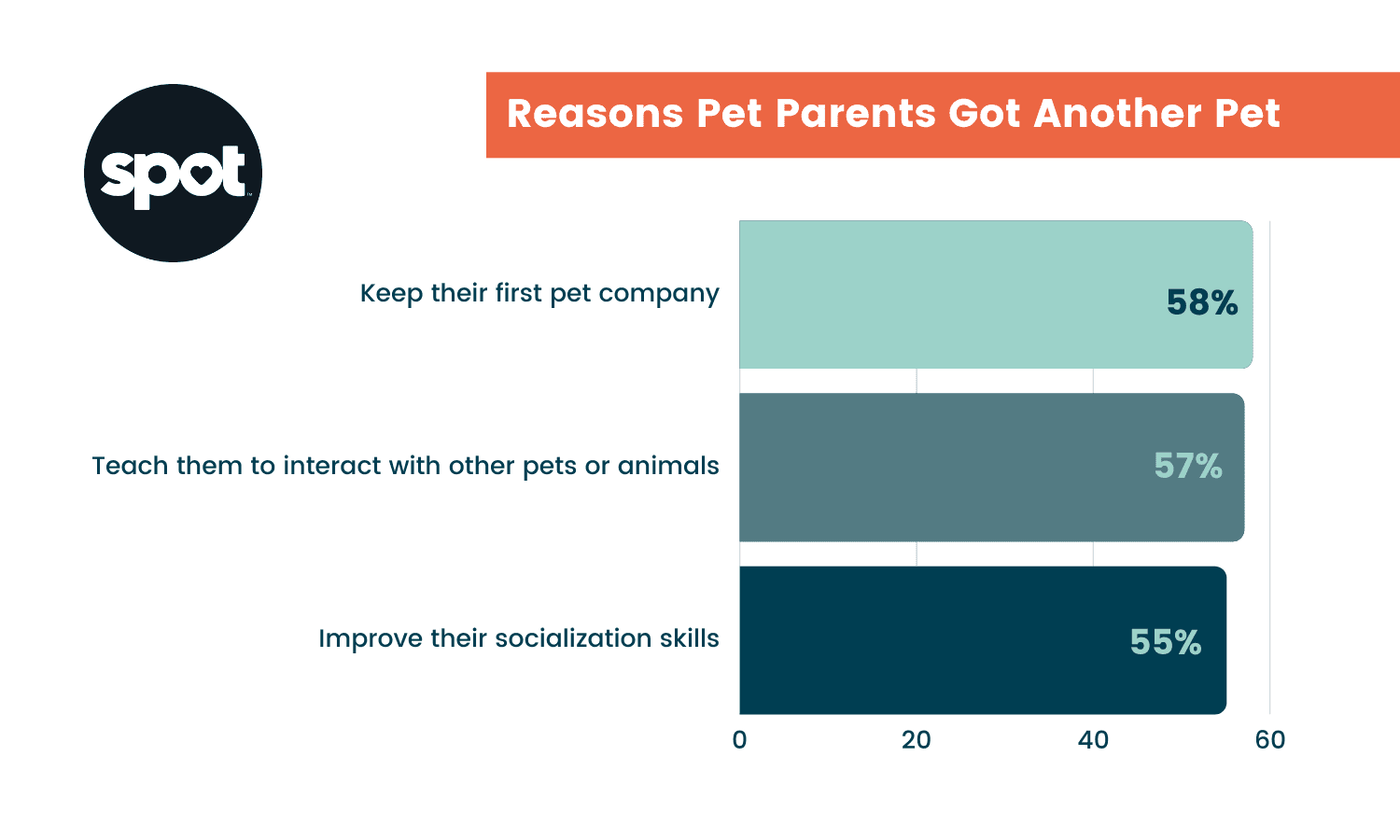
Separation Anxiety
Another trend that was noticed by pet parents was an increase in separation anxiety in dogs. In 2021, 58% of pet parents agreed that COVID has increased their pet’s separation anxiety.
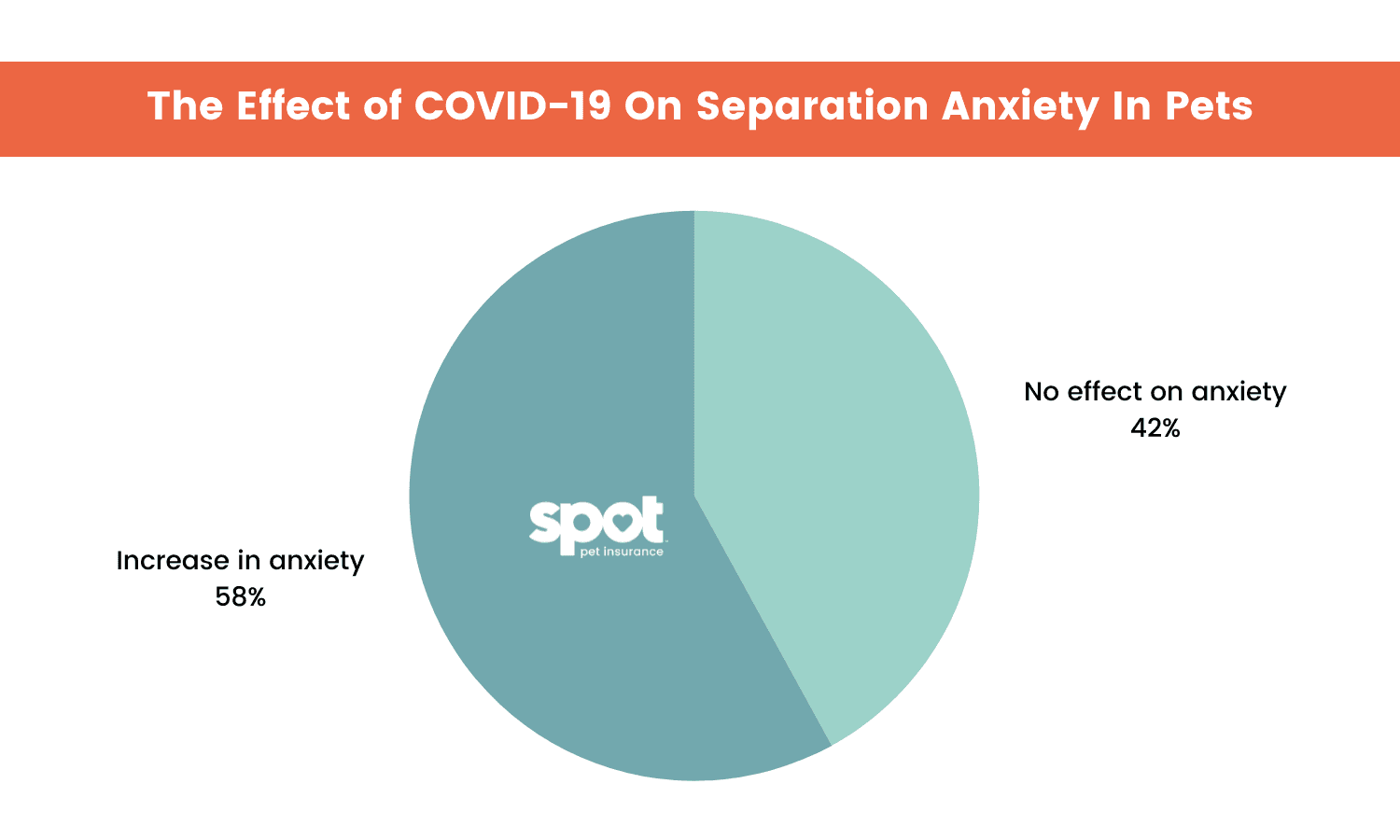
Ways to improve a pet’s social life
Last year, pet parents said they did the following to improve their dog’s social life:
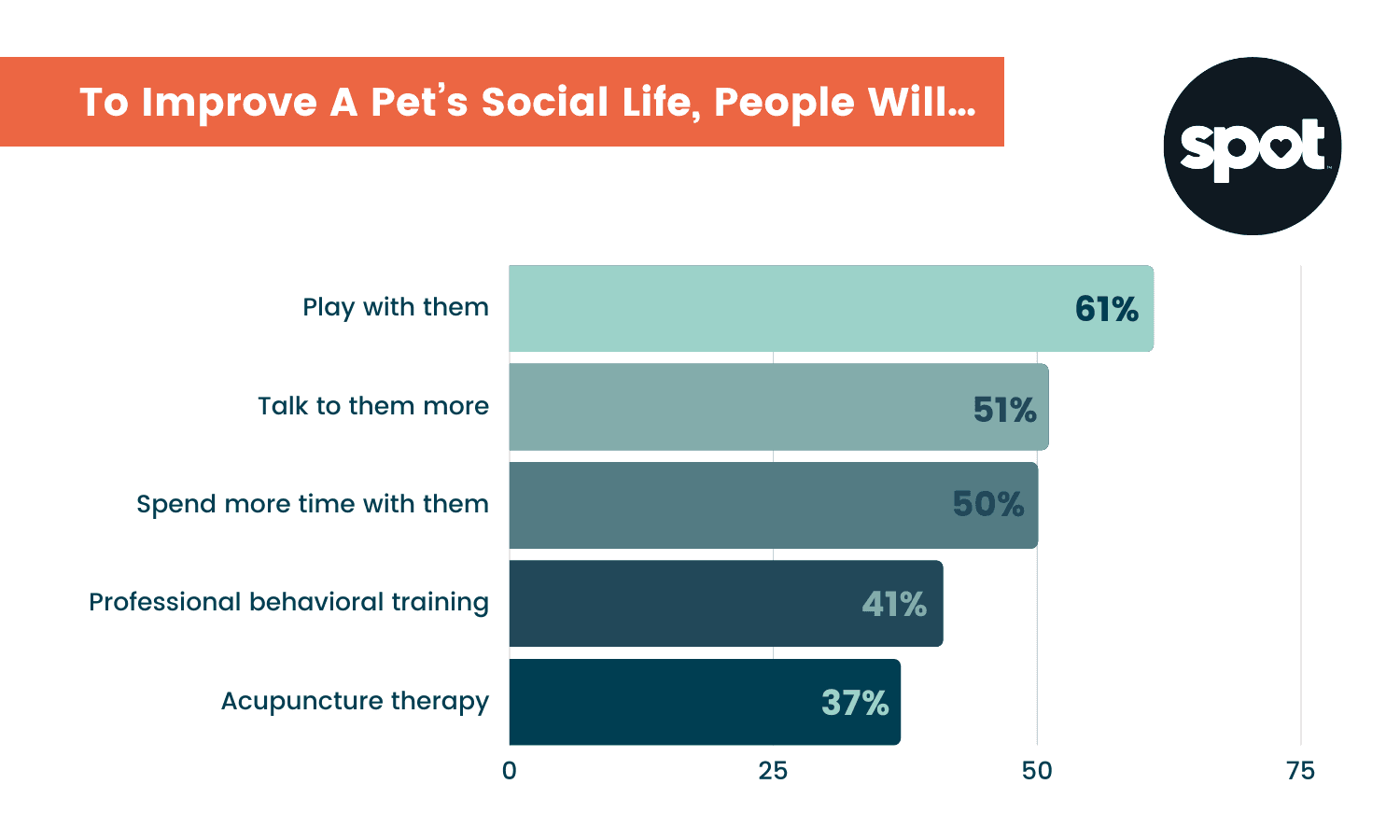
Returning to the office
For pet parents that returned to the office after working from home with a dog, here is what they did to help their pets:
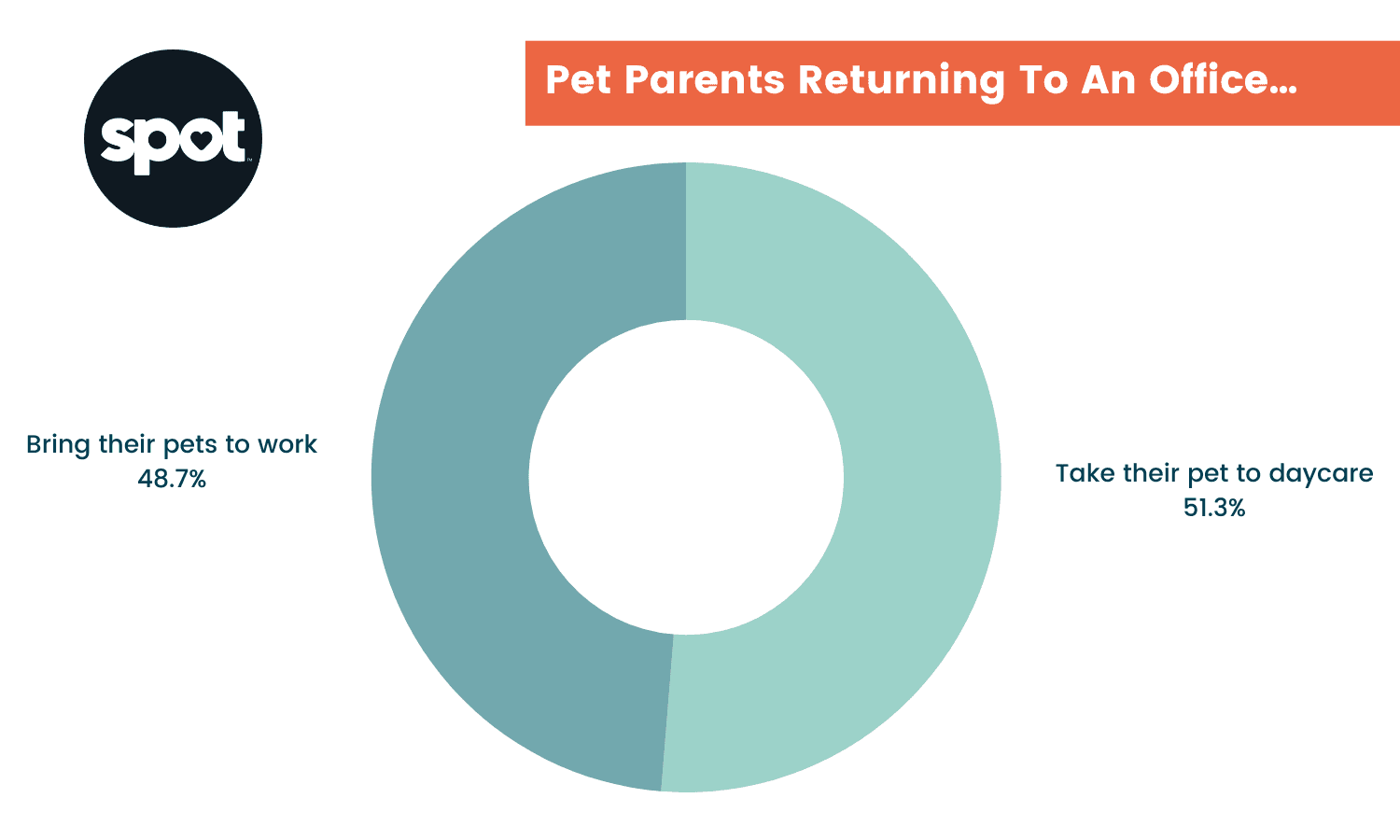
At-Home Dog Training Tips
Behavioral issues may stem from this sudden change in lifestyle. The good news is that this negative behavior can be corrected with proper training. Here are some common behavioral changes and what pet parents can do about it (right at home).
Shelby Semel
Canine Behavior Expert & Trainer
Benjamin Bennink
APDT Vice Chair, Certified Professional Dog Trainer & Behavior Consultant
Fanna Easter
APDT Chair, Certified Professional Dog Trainer & Behavior Consultant
Benjamin
Why is my dog behaving this way?
“Puppies obtained during the peak of isolation restrictions during covid are less likely to have been socialized. Socialization is a period during a puppy’s development before about four months of age during which they learn what is normal in the world and what they can expect from interactions with those normal things. With lifted restrictions comes a lot of changes in their lives and a lot of new things that were not introduced during the critical socialization period of their development. Luckily, all is not lost and most of the problem behaviors that can arise from the major changes in these dogs’ lives can be helped with work.”
My dog has become more aggressive
Shelby
Why is this happening?
“It is important to first rule out anything medical, especially if the behavior change was sudden. Make an appointment with your vet and go from there! Training won’t fix anything (and could make it worse!) if the underlying cause is pain or discomfort. Another issue could be that the dog was never properly socialized when under 16 weeks old. Due to Covid, many people did not expose their dogs to new people entering the home and didn’t get them to puppy classes. Months down the road, we see the effects of this!”
What can I do about it?
“If medical issues are thoroughly ruled out, we’d want to look into environmental stressors. I like to make a ‘trigger list’ to narrow down what is causing the aggression or reactivity. Is it when you are brushing their teeth? Putting on their harness? Taking a toy away? When a dog approaches you? When a friend comes over? You need to diagnose the problem first and foremost to then create a plan to work on it! Contacting a certified professional dog professional to help is a good first move.”
Benjamin
“Environmental changes can also increase aggression. In addition to the above advice to attempt to gradually ease into changes in the environment, managing aggressive responses becomes a matter of safety. With any sudden increase in aggression, consulting with a veterinarian to rule out medical causes is paramount. Beyond that, gradual exposure and counter-conditioning with high-value motivators (food, games, toys, etc) is the typical best course of action to help the dog feel less stress and more comfort. Avoid methodology that increases stress, fear, or pain to the greatest extent possible. Respect a dog’s aggressive behaviors as a form of communication that they are uncomfortable, and remember that the goal is to increase their comfort not to punish the behavior. For anything beyond growling, working with a professional to minimize the risks involved is important. Find a trainer experienced with helping with aggressive behavior in a way that optimizes the dog’s comfort and minimizes their stress.”
My dog has become noticeably needier
Shelby
Why is this happening?
“Dogs can become needier if you have been around more often for a long period of time (cough, cough, covid times) or even just if you were homesick for a week and they got used to it.”
What can I do about it?
“Work on paying them a little bit less attention while you’re home. Giving them more exercise and mental stimulation to tire them out and leaving them with a high-value bone or toy when you leave for short periods of time is a good start!”
My dog is not responding to commands
Shelby
Why is this happening?
“Typically, when a dog is not responding to cues, it is because they are confused. Humans tend to ask for things that the dog has not properly learned or generalized yet (for instance, they have learned to lay down in the living room, but humans want them to do it in the middle of the dog park). Another reason dogs stop responding to cues is that there is nothing in it for them! If there is no reinforcement, why listen? Would you go to work if you weren’t getting paid? I wouldn’t!”
What can I do about it?
“Set your dog up for success. Start easy and slowly work your way up by adding distance, distractions, or duration. Do not attempt to make multiple aspects of what you are asking for harder at once. Work on proofing cues in new places and with new people. “Proofing,” in dog training means practicing a behavior in different environments and situations, until your dog generalizes the desired behavior and can do it anywhere, even with distractions.”
Benjamin
“Chewing is another stress response that is typical behavior for dogs, and caused by owners being away from home more, or having more people in the house. Similar to jumping, you’ll want to ease your dog into new changes. In the case of chewing, ensure your dog has a safe environment with access to plenty of appropriate things to chew on to help them manage their stress. Food-dispensing toys, bully sticks, chew toys, and many others may fit the bill, a veterinarian is a good resource to discuss what’s safest for any individual dog.”
My dog is excessively barking
Shelby
Why is this happening?
“There could be many reasons why your dog is constantly barking at home. One of the most common reasons is barking to get your attention. Other reasons for barking are due to separation anxiety (if your dog is barking while you’re away), frustration, stress, or even boredom.”
What can I do about it?
“The number one thing to do is to make sure your dog gets plenty of exercise! An under-stimulated puppy is more likely to bark, while a tired pup is less likely to exhibit this behavior. For attention barking, try turning your back on your dog or getting up and leaving the room. These are very clear-cut signals that barking is getting the opposite of what the dog wants; he’s losing out on the opportunity to receive your attention. Do not feed into their attention-seeking behavior by talking to them or petting them.”
My dog is howls and whines a lot
Fanna
Why is this happening?
“A few weeks after the pandemic started, many pet parents noticed that their dogs were suffering from separation anxiety. With everyone staying or working from home, it became the perfect storm for separation anxiety. Dogs were no longer home alone during the day, and most pet owners noticed an increase in barking, howling, destroying the home, pacing, and other behaviors when dogs’ were alone while running short errands. This behavior has increased when pet parents started going back to work.”
What can I do about it?
“To address separation anxiety, it’s best to seek advice from your veterinarian AND a Certified Separation Anxiety Trainer (CSAT). For best results, always part with your veterinarian first and then reach out to a CSAT for behavior modification. There is hope!”
My dog is jumping on me
Shelby
Why is this happening?
“It is completely normal behavior for dogs and puppies to jump – it’s how your dog shows affection and a way for them to receive attention. As your dog gets older and bigger, we eventually would like to stop this behavior – what was cute as a puppy could be considered rude or even dangerous behavior, particularly with children or the elderly.”
What can I do about it?
“Do not reward your dog for jumping on you when they greet you. Avoid exchanging enthusiastic greetings when your dog jumps on you. If you acknowledge this behavior with positive reinforcement, they may continue to do this because they are getting the attention they are seeking. Training them to sit, and rewarding them when they calming greet you can help correct jumping. And of course, be sure to regularly exercise your pup.”
Benjamin
“Jumping is a typical stress response for dogs. In addition to jumping, you’ll likely find that your dog will follow you around. When jumping occurs, a dog is attempting to be closer to you. There are two major categories of stressors being added as pandemic restrictions are lifted: owners being away from home more, and more people in the house. Ease your dog into these changes as much as possible by making the duration of absences or visits as short as possible (gradually longer) and as low intensity as possible is key.”
My dog is chewing on everything
Shelby
Why is this happening?
“Chewing is expected when you have a puppy. It is completely normal behavior for puppies.”
What can I do about it?
“Provide your pup with his or her own toys and teach them how to use the toy. Another step to take is to make sure they get enough exercise. A tired dog is a well-behaved dog. If you catch your pup inappropriately chewing, interrupt the behavior with ‘hey’ or clapping. A pro-tip for pet parents is to rotate chew toys, so your dog always has something new or exciting for them to chew on. If you are leaving the home, or want your dog on their best behavior, save the highest value chews for these times.”
Benjamin
“Chewing is another stress response that is typical behavior for dogs, and caused by owners being away from home more, or having more people in the house. Similar to jumping, you’ll want to ease your dog into new changes. In the case of chewing, ensure your dog has a safe environment with access to plenty of appropriate things to chew on to help them manage their stress. Food-dispensing toys, bully sticks, chew toys, and many others may fit the bill, a veterinarian is a good resource to discuss what’s safest for any individual dog.”
Shelby Semel is a New York City-based canine behavior expert and trainer who promotes and utilizes positive reinforcement dog training. She is Certified by the Certification Council for Professional Dog Trainers, and is a member of the Association of Pet Dog Trainers (APDT).
Fanna Easter is on the APDT board of directors and has been instructing dog training group classes and in-home behavior consults for over 30 years. She is a Certified Dog Behavior Consultant and Certified Professional Dog Trainer with a special focus on separation anxiety, earning her Separation Anxiety Dog Trainer certification.
Benjamin Bennink is on the APDT board of directors and has trained dogs professionally since 2010. He is a veteran of the US Navy and currently owns and operates Good Doggy Saratoga in upstate New York.

Training Your Dog Online
A bright spot of the pandemic is that technology has made it easier to communicate. Over the past few years we have relied on video platforms like Zoom and GoToMeeting to communicate. Dog training is no different! These days, there are several options for online dog training, with courses that can be completed by you and your pup at home. Whether you sign up for a group class, or virtual 1-on-1 meeting with a trainer, there are many reasons to consider virtual training over traditional personal training for dogs, particularly for pandemic pups.
Michael
To help understand how the virtual dog training process works, we had Dog behaviorist Michael Baugh weigh in on the benefits of online training and what pet parents can expect.
Reasons to train dogs online (vs traditional training)
“At Michael’s Dogs we see nearly half of our clients online. This has allowed me to work with clients as far away as Beijing, China, the Dominican Republic, and many US States outside our immediate service area. Almost all of our clients have an initial online consultation before meeting in-person. It’s not just a matter of convenience. Online Training is actually more effective in many cases.”
Why try virtual dog training over traditional dog training? There are several reasons why training your dog online may be a better fit.
Reason #1: Access to video and text
Online classes offer the advantage of having both text and video to learn new behaviors.
“Self paced online classes are a great option. You can earn at our own speed, review lessons, and practice when it’s most convenient. Many positive reinforcement trainers are offering these and some include an element of live online interaction with the trainer too.”
Reason #2: Pause, rewind and replay
With a virtual class, your trainer will likely provide a recording of the class, meaning you can go back and visit the session, with the ability to pause, rewind, and replay key points.
Reason #3: Flexibility
You can replay the videos to work at your dog’s pace. You can also choose the day or time that works best for you and your dog.
“Classes and private behavior consultations are easy to book online yourself, no playing phone tag to call a trainer and schedule an appointment. You can pick the time and date that works for you, pay online, and you’re done.”
Reason #4: Less distractions
In comparison to traditional classes, online classes can be less distracting for your dog. If you think about it, nearly all training occurs at home, so why travel to another place to do it? Rather than bring them into a new environment, they can learn in the familiarity of their home.
“For dogs who are afraid of strangers or are aggressive towards visitors, we end up spending a large portion of the consultation just calming the dog down. An online consultation makes much more sense, at least for the initial meeting so that our human client and their dog can learn in a less-stressful environment. The dog doesn’t have to worry about a new person invading is space and the human client doesn’t have to worry about their dog’s behavior.”
Reason #5: Calm environment
If you have a dog that struggles with stress or anxiety, online classes are ideal. Being at home is more of a calming environment for training.
What pet parents should know about online dog training
For pet parents that are new to virtual training, here are a few considerations before you sign up for your first course:
Basic commands
Training classes online are typically best for basic commands, and dealing with common behaviors like chewing, jumping, or biting.
“Online coaching is the industry standard for Separation Anxiety cases. And, more than 80% of our cases are fear and aggression. All of the great attributes of online coaching apply to those cases as well.”
Behavior outside of the home
Online training is not great for socialization, or misbehavior that tends to happen exclusively outside of the home.
“That said, if you’re working with an experienced and educational behavior professional, he or she can give you great advice related to socialization and social interactions outside the home. And technology allows us to do remote coaching anywhere there is a strong signal – so that doesn’t just have to be your home.”
Choose a familiar area of your home
Decide where in your home to do the virtual classes, and make sure your dog is used to the area of the house.
Supplies needed
You’ll likely need to purchase your own supplies to bring to our virtual class. Trainers should have a list of products to bring, but you will be responsible to bring them.
Complex issues
If you’re considering whether online training is right, some issues may be too complex for trainers to handle online.
“The key is finding a trainer who has experience and a track record of successful outcomes in the area of expertise you need. Don’t go to an aggression trainer if you need help in the Agility ring. And of course, the other factor to consider is the trainer’s experience with offering online coaching and classes. The more fluent they are in the process the easier it will be for you.”
Camera & lighting
With online training, your training will not only need to see your pup, but they will likely want to monitor the parent’s body language. Be sure to set up your camera at the right angle, and that there’s great lighting in the room of your home.
In Closing
The pandemic has left a ripple effect on our day-to-day lives. People are returning to work and as a result, leaving their dogs at home. This lifestyle change is not only overwhelming for humans, but it’s also stressful for your canine companions. Take the necessary steps to ease your dog’s stress and anxiety.
In addition to good training, dog insurance plans from Spot Pet Insurance ensure that you and your pup are covered in case of accidents and illnesses. Learn more about pet insurance from Spot to keep your dog happy and healthy.

With 10 years of experience as a pet parent, I aim to empower pet owners with insights into pet insurance and maintaining their pet's well-being. I aspire to be a trusted source, combining knowledge with a commitment to the welfare of our beloved pets.












